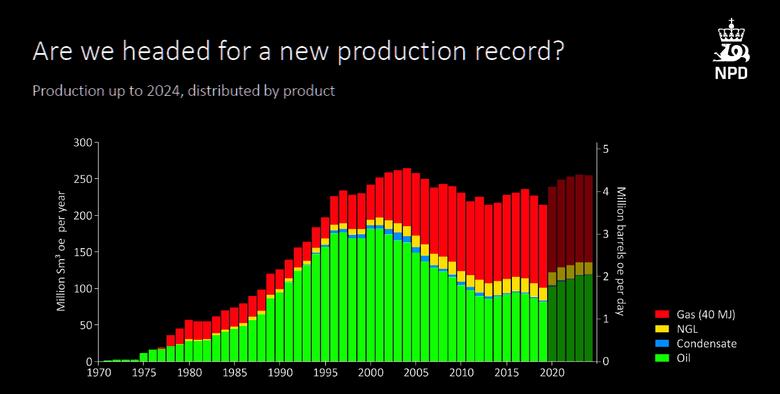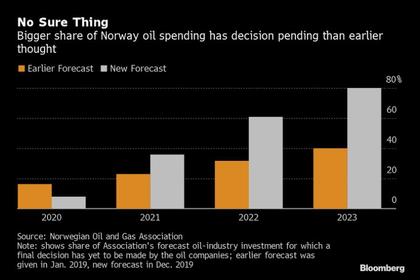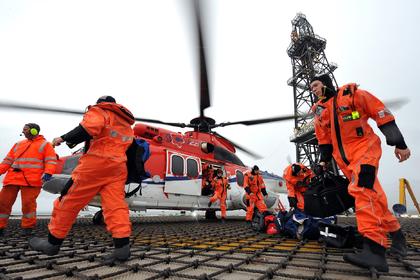
NORWAY'S OIL WILL UP

NPD - 09/01/2020 - The Shelf in 2019 – a good year overall
Activity on the shelf was high last year. There are considerable resources in fields and discoveries, and more yet to be discovered in all sea areas. A record number of fields are producing.
"We have a good foundation for continued high value creation from the oil and gas industry for a long time to come", says Director General of the NPD Ingrid Sølvberg.
The Norwegian Petroleum Directorate works on value creation from the industry by ensuring that all profitable resources are produced – not only the ones that are easiest to extract. In this effort, the companies must take into account safety, the external environment and other users of the ocean.
"Value creation is the driving force behind the work we do", the Director General emphasises.
She points out that, over the last fifty years, the petroleum industry has created tens of thousands of new jobs and developed expertise and new technology. The industry has also filled the nation's coffers. In 2019, the Government Pension Fund - Global reached a milestone with a market value of ten thousand billion kroner.
A lot of wells, a lot of discoveries
57 exploration wells were spudded in 2019, 4 more than the previous year. Many of these were drilled in under-explored areas.
A total of 37 exploration wells were drilled in the North Sea, 15 were drilled in the Norwegian Sea and 5 in the Barents Sea.
"It is reassuring that the industry still has significant faith in the Norwegian shelf; in 2020, we expect about 50 exploration wells", says Sølvberg.
She explains the high exploration activity with, among other things, the companies having attractive areas to explore, in addition to cutting costs and improving profitability.
83 production licences were awarded in 2019 in the Awards in Pre-defined Areas (APA 2018). This is a new record. The new production licenses cover vast areas across the entire Norwegian shelf.
There was also a good number of applications for the APA round announced in 2019. Awards will most likely take place in January.
Small discoveries also create values
The use of new technology and technology development is important in order to find and extract more of the profitable resources. For example, the development in seismic technology in recent years has resulted in much sharper images of the subsurface.
A total of 17 discoveries were made in 2019, 10 in the North Sea, 6 in the Norwegian Sea and 1 in the Barents Sea. Several of the discoveries are relatively small, but they could nevertheless provide substantial value for licensees and for society. Small discoveries near existing infrastructure can yield highly profitable developments since it is relatively easy and reasonable to tie them into nearby platforms and pipelines.
New discoveries help keep production at a high level. Since 2011, an average of 80 million standard cubic metres (Sm3) of oil equivalent (o.e.) has been proven each year, which is around one-third of the yearly production from the Norwegian shelf.
"The companies are generally making a lot of discoveries. The last two years have seen a marked increase in proven volumes compared with the three previous years. This shows that there is a connection between the number of exploration wells drilled and discoveries made", says the Director General.
She points out that there are significant opportunities in undiscovered resources across the entire shelf, and that many areas warrant further exploration.
Record number of fields in operation
At the end of the year, there were 87 producing fields, which is a new record. Most of the oil and gas still comes from the major fields. About half of the fields are subsea developments tied into other infrastructure.
"Small subsea fields can also create substantial values. They also help extend the period of profitable production from the host fields", says Sølvberg.
Last year was the 50th anniversary of the discovery of the Ekofisk field. It is still producing, and will continue to deliver for decades to come. So will the most recent giant, Johan Sverdrup. Sverdrup will contribute vast revenues for society for many decades.
Toward a new production record
The Norwegian Petroleum Directorate projects that the overall production of oil and gas in 2024 will be close to the record year 2004 – among other things due to Sverdrup and because the Johan Castberg field in the Barents Sea is scheduled to come on stream in 2022.
While oil accounted for most of the production in 2004, gas will account for about one-half in 2024.
Later, increasing volumes of production will come from projects that must be approved on fields, discoveries that must be developed and resources that have yet to be discovered:
"In order to reach this goal, the companies have to approve and initiate measures to improve recovery from fields in operation. Decisions must also be made to develop new fields. They also have to explore for and make new discoveries to develop", the Director General points out.
Overall production declined somewhat in 2019 compared with the previous year. This was caused by somewhat lower gas production than expected. The companies chose to hold back due to the market situation – but the Norwegian Petroleum Directorate expects this to turn around in 2020.
New fields coming on stream, and particularly Johan Sverdrup, will more than outweigh the decline in oil production from many of the other fields.
The giant Johan Sverdrup
Johan Sverdrup is proof positive that exploration in mature areas pays off. The field, which came on stream in autumn last year, is the third largest oil field on the shelf – and already accounts for around 20 per cent of Norwegian oil production.
The fact that Sverdrup is operated with power from shore reduces emissions by approx. 620,000 tonnes of CO2 per year, or 25 million tonnes throughout the lifetime of the field.
Sverdrup is scheduled to produce for at least 40 years, and total revenues from production (2018 NOK) are calculated at more than NOK 1,400 billion.
According to figures from operator Equinor, this means NOK 900 billion in revenues for the Norwegian State. This revenue comes from taxes and the State's ownership of Petoro.
Three fields in addition to Sverdrup – Oda, Trestakk and Utgard – came on stream in 2019. All three are subsea developments tied into existing host fields.
In 2019, the authorities approved plans for development and operation (PDOs) for seven fields. The largest was the second development stage of Johan Sverdrup. The six others have an overall current value of NOK 38 billion.
"Despite being dwarfed by Sverdrup, they represent significant financial value for society", says Ingrid Sølvberg.
New technology provides new opportunities
At the end of 2019, 25 fields were no longer producing on the Norwegian shelf. One field that has not been producing is Tor, and it is scheduled to start back up at the end of 2020.
Tor is located in the Greater Ekofisk Area, and was producing from 1978 to 2015. Technology that was not available when the field was developed int 1978 makes it profitable to redevelop Tor, this time as a subsea development tied into Ekofisk.
A study conducted by the NPD in 2019 showed that there are considerable opportunities to improve recovery using advanced methods (EOR, enhanced oil recovery). Another study shows that there is also a substantial potential for producing more oil and gas from tight reservoirs, which means reservoirs where it is difficult to get oil and gas flowing due to low permeability.
The NPD's most important job is to ensure that petroleum activities generate the greatest possible values for society. This means that all profitable barrels must be produced, not just the simplest ones.
"The NPD wants new technology and advanced methods to be tested not only in laboratories, but also on the fields", says the Director General.
Higher production, lower emissions
Reserve growth has been good in recent years. This is caused by, among other things, the approval of seven development plans for fields in 2019, and the companies' implementation of measures to improve recovery from existing fields. Up to 90 discoveries are being considered for development.
Petroleum production will increase in the coming years, and at the same time, emissions are on the way down. This shows that policy instruments such as an emission credit price and CO2 tax work; they make it profitable for the companies to reduce emissions.
The greatest potential for cutting emissions is in efficient operation of turbines or the introduction of alternative power sources – for example power from shore.
When the area solution for power from shore on the Utsira High is in place in 2023, more than 40 per cent of production according to approved plans will be operated with power from shore. This percentage is expected to increase significantly toward 2030 if the companies implement the plans they are currently working on.
Capture and storage of CO2 is another important measure to reduce emissions. This is a focus area for Norway, which has started a full-scale demonstration project.
The plan is to capture CO2 from two large emission points in Telemark and Oslo and transport it to Kollsnes for intermediate storage. From here, it will be transported to subsurface storage south of the Troll field in the North Sea.
The NPD has mapped opportunities for safe storage sites on the shelf.
2019 saw the first award of an exploitation licence to store CO2 on the Norwegian shelf, and an exploration well is currently being drilled to investigate whether the reservoir is suitable for safe storage. The Plan for Development and Operation (PDO) is expected in spring 2020.
Investments: Expectations for a stable high level in the next few years
The petroleum industry pays about twice as much tax as all other land-based industries combined (source: Statistics Norway).
The State's net cash flow from the sector, which means revenues from tax, revenues from the State's direct ownership in fields (Petoro), ownership interest in Equinor and other taxes constitutes between 80 and 90 per cent of the net cash flow from the activities.
The NPD's forecasts of production, costs and investments from year to year are therefore an important foundation when the Government creates budgets and analyses.
In 2019, investments (except exploration) are estimated at around NOK 150 billion. This is 17 per cent higher than in 2018. The same level is expected in 2020, before it will decline somewhat.
The high investment level is caused in part by multiple new fields under development, and the implementation of further development projects.
The NPD's forecasts presume moderate growth in the cost level moving forward.
"As regards value creation from the shelf in general, and as regards profitability associated with new projects in particular, it is crucial that the companies are able to avoid new substantial cost spiral", the Director General emphasises.
Overall investments and costs associated with activity on the Norwegian shelf totalled around NOK 250 billion in 2019. The development of new fields and investments in fields in operation account for most of the activity and use of resources, but extensive amounts were also spent on exploration and operation.
About NOK 60 billion was spent in 2019 to operate fields, pipes and onshore facilities.
The high activity level on the shelf in 2019 appears to continue in 2020, and will then decline somewhat leading up to 2024. The increasing production provides a basis for vast revenues from the oil and gas industry for years to come.
More than half of the resources left
The NPD's analyses show that around 48 per cent of resources have been produced. This means that more than half have yet to be discovered and produced. Of these, decisions have already been made to produce around 18 per cent. Of course, it is impossible to say how much remains to be discovered, but the NPD's analyses indicate that this constitutes as much as 25 per cent of the total.
There are good opportunities for discovering oil and gas across the entire shelf. The NPD's projection of undiscovered resources is about as before for the North Sea and Norwegian Sea, while expectations have been lowered in the Barents Sea Southeast due to dry wells. However, the expectations for undiscovered resources in central parts of the Barents Sea have been increased due to the mapping of several prospects and much good work in the production licenses.
The effort to map the shelf as regards potential oil and gas resources is part of the NPD's assignment.
In the summer of 2019, the NPD collected 3D seismic in the northeastern part of the Barents Sea, along the border with Russia. These data are currently being processed, and the results will be included in the NPD's future resource evaluations.
New times, new tasks
The Seabed Minerals Act entered into force in July 2019. It aims to facilitate exploration for and extraction of mineral deposits on the shelf. The NPD has been tasked with mapping mineral deposits, preparing an overview of existing data and assisting the Ministry in a potential opening process.
The NPD collected samples and mapped the topography on the seabed in parts of the Norwegian Sea in both 2018 and 2019. Sulphide and manganese crust deposits were proven.
-----
Earlier:














